Related Research Articles

The Most Honourable Order of the Bath is a British order of chivalry founded by King George I on 18 May 1725. Recipients of the Order are usually senior military officers or senior civil servants, and the monarch awards it on the advice of His Majesty's Government.The name derives from an elaborate medieval ceremony for preparing a candidate to receive his knighthood, of which ritual bathing was an element. While not all knights went through such an elaborate ceremony, knights so created were known as "knights of the Bath".
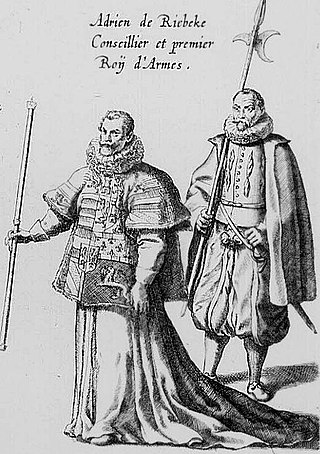
King of arms is the senior rank of an officer of arms. In many heraldic traditions, only a king of arms has the authority to grant armorial bearings and sometimes certify genealogies and noble titles. In other traditions, the power has been delegated to other officers of similar rank.

Sir Albert William Woods was an English officer of arms, who served as Garter Principal King of Arms from 1869 to 1904. The Woods family has a strong tradition of service at the College of Arms. Albert Woods was the son of Sir William Woods, Garter King of Arms from 1838 until his death in 1842. Likewise, the grandson of Albert Woods was Sir Gerald Woods Wollaston, who also rose to the rank of Garter King of Arms and served there from 1930 until 1944.
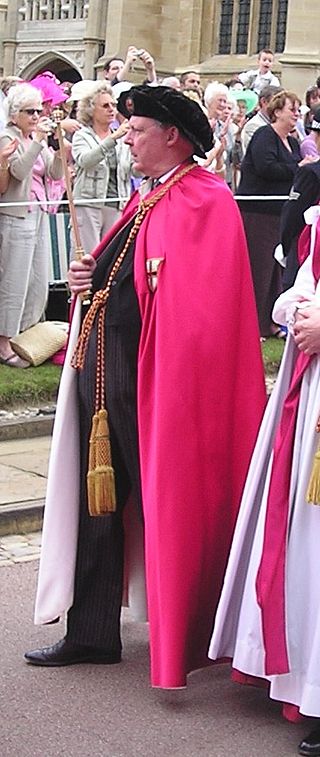
Sir Peter Llewellyn Gwynn-Jones was a long-serving Officer of Arms at the College of Arms in London. He was Garter Principal King of Arms, the senior English officer of arms, from 1995 to 2010.

Garter Principal King of Arms is the senior king of arms and officer of arms of the College of Arms, the heraldic authority with jurisdiction over England, Wales and Northern Ireland. The position has existed since 1415.

David Vines White is an officer of arms at the College of Arms in London. Since 2021, he has served as Garter Principal King of Arms.
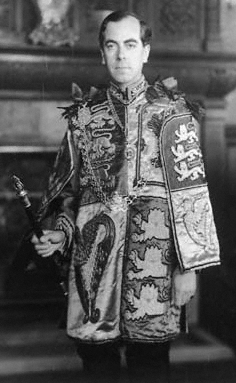
Sir Anthony Richard Wagner was a long-serving officer of arms at the College of Arms in London. He served as Garter Principal King of Arms before retiring to the post of Clarenceux King of Arms. He was one of the most prolific authors on the subjects of heraldry and genealogy of the 20th century.
Sir Henry Farnham Burke, (1859–1930) was a long-serving Anglo-Irish officer of arms at the College of Arms in London.
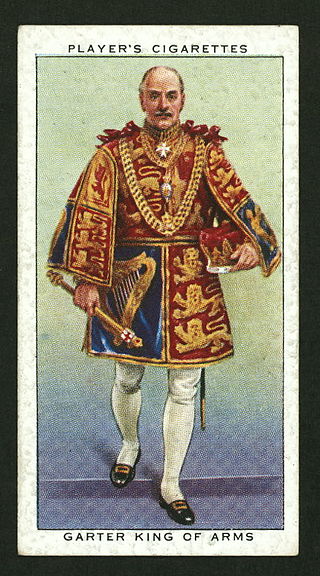
Sir Gerald Woods Wollaston was a long-serving officer of arms at the College of Arms in London. Wollaston's family had a firm tradition at the College of Arms. Wollaston's great-grandfather was Sir William Woods, Garter Principal King of Arms from 1838 until his death in 1842. His grandfather was Sir Albert William Woods who held the same post from 1869 to 1904.

Sir Algar Henry Stafford Howard was a senior British Army officer and long-serving officer of arms at the College of Arms in London. He served as the Garter Principal King of Arms from 1944 to 1950 before retiring. He was the third consecutive Fitzalan Pursuivant of Arms Extraordinary to attain the highest rank at the College of Arms.
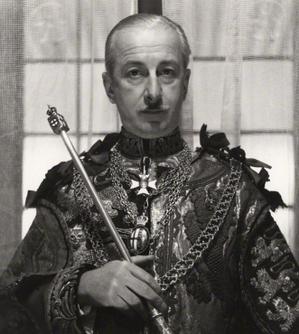
Sir George Rothe Bellew,, styled The Honourable after 1935, was a long-serving herald at the College of Arms in London. Educated at the University of Oxford, he was appointed Portcullis Pursuivant in 1922. Having been Somerset Herald for 24 years, he was promoted to the office of Garter Principal King of Arms in 1950, the highest heraldic office in England and Wales. He served in that capacity until his resignation in 1961. As Garter, Bellew oversaw the funeral of George VI, proclaimed the late King's daughter, Elizabeth II, as Queen and took a leading role in the organisation of her Coronation in 1953. After his retirement, Bellew was Secretary of the Order of the Garter and Knight Principal of the Imperial Society of Knights Bachelor. He lived for many years at Dower House in Old Windsor, Berkshire, but later moved to Farnham and died in 1993, aged 93.
Gordon Ambrose de Lisle Lee was a British officer of arms, an expert in Japanese art and heraldry and a stage designer.

Walter Aston Edward Blount Esq. FSA was a long-serving officer of arms at the College of Arms in London. He was born the eldest son of Edward Blount, the third, but second surviving, son of Sir Walter Blount, 6th Baronet of Sodington, Worcestershire.

Blanc Coursier Herald was an officer of arms in England in the 18th and 19th centuries, associated with the Order of the Bath. The name of the office derives from the white horse in the arms of the Hanoverian monarchs.
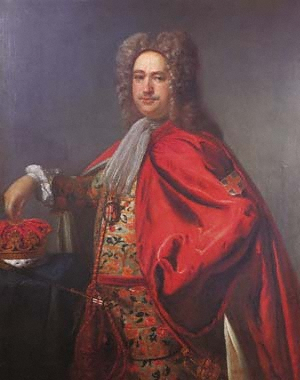
John Anstis was an English officer of arms, antiquarian and politician who sat in the House of Commons between 1702 and 1722. He rose to the highest heraldic office in England and became Garter King of Arms in 1718 after years of political manoeuvring.

John Anstis was an officer of arms at the College of Arms in London.

Stephen Martin Leake was a numismatist and long-serving officer of arms at the College of Arms in London.
Sir William Woods KH FSA was an officer of arms at the College of Arms in London. Woods was a bastard of unknown paternity. He used the name and arms of George Woods, a London tailor, but was said to be the son of the Duke of Norfolk. George IV was a close friend. In 1815 Woods was appointed Secretary to the Knights-Commander and Companions of the Order of the Bath, and registrar of the Guelphic Order, and in 1819 he became Bluemantle Pursuivant at the College of Arms. He was appointed Clarenceux King of Arms in 1831, and promoted to Garter in 1838.

Sir George Nayler, KH FRS was a long-serving officer of arms at the College of Arms in London.

English heraldry is the form of coats of arms and other heraldic bearings and insignia used in England. It lies within the so-called Gallo-British tradition. Coats of arms in England are regulated and granted to individuals by the English kings of arms of the College of Arms. An individual's arms may also be borne 'by courtesy' by members of the holder's nuclear family, subject to a system of cadency marks, to differentiate those displays from the arms of the original holder. The English heraldic style is exemplified in the arms of British royalty, and is reflected in the civic arms of cities and towns, as well as the noble arms of individuals in England. Royal orders in England, such as the Order of the Garter, also maintain notable heraldic bearings.
References
- ↑ Bath, Order of the (September 14, 1812). "Statutes of the Most Honourable Order of the Bath". Printed in 1725--reprinted in 1812 by T. Harper, Jun. – via Google Books.
- ↑ "Bath King of Arms | DrawShield". drawshield.net.
- ↑ Burke's Peerage (1939 edition), s.v. Warwick, Earl
- ↑ "Four Knights Grand Cross installed in Bath chapel". Westminster Abbey. 20 July 2021. Retrieved 1 May 2023.